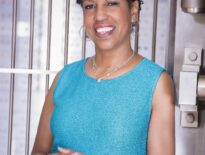Berkeley Investments’ Graphic development in Sullivan Square blends the Cambridge Street site’s industrial history with bold modern design elements. Photo courtesy of Berkeley Investments
Berkeley Investments has a long and successful history of pioneering adaptive reuse developments. From our portfolio in Fort Point to the Waltham Watch Factory and Metro9 condos in Somerville, making old buildings new again has been an important and strategic part of our business for more than a decade.
The Graphic in Charlestown is the latest project to follow in this tradition. With the final phase having just opened in September, the project’s 171 units are already over 80 percent leased. The Graphic features two distinct buildings; the adaptive reuse of 32 Cambridge St., formerly known as The Graphic Arts Finishers building, built circa 1920, and a new structure at 34 Cambridge St., which utilized a modular construction method.
That’s right: Two buildings with two distinct construction methods, brought together in one well-received multifamily development.
A Serendipitous Discovery
32 Cambridge St. was a well-worn industrial building located just across the street from the MBTA’s Sullivan Square Station on the Orange Line, next to Hood Park, and a stone’s throw to Assembly Row and the new Encore casino. The building offered oversize 15–by–8–foot factory windows, 14–foot ceilings and massive, exposed, old–growth Douglas fir beams. The building was home to The Graphic Arts Finishers for over four decades, and Berkeley was able to partner with the original owners to bring new life to the site as they transitioned their business.
No matter how precise the measurements, how detailed the historic blueprints, old buildings tend to be shy and simply refuse to share all their secrets up front. 32 Cambridge was no exception. Making old buildings new again requires fortitude, and to do it well, expertise and vision.
Rather than fight the building’s idiosyncrasies, Berkeley encouraged the design team, led by ICON Architecture, to embrace them. A one–off cargo opening became a French balcony; the existing stair towers became bedrooms; and the original elevator shaft was reborn into a karaoke room.
The building’s 46 units’ plans were tailored to enhance the building’s features, layouts were aligned to celebrate the windows, building systems selected to keep the brick and beams exposed and demising walls were jogged to cleanly feature the building’s steel columns. The most serendipitous, unforeseen element was the discovery that the interior bricks were not painted gray, but were in fact concrete bricks, which provided a more neutral and contemporary backdrop for the new interiors. Elements of surprise like this are typical of adaptive reuse and create a depth to the project narrative through the expression of often long obscured historical elements.
Mix of Old and New
It doesn’t stop at the structure. From salvaged fire doors and vintage factory furniture, to reusing historic rail bumpers, adaptive reuse presents many opportunities to bring the history of a site to life in a new context. In the process, you create a one-of-a-kind narrative-of-place most new buildings would envy.
However, in addition to the adaptive reuse of 32 Cambridge, Berkeley was also building a new structure with 125 additional units next door at 34 Cambridge St. Utilizing a modular construction technique, this building featured a very different look and feel. The challenge was how to make these two very distinct buildings feel complementary and to communicate to each other in an authentic manner.

Paul Goodwin.
The Graphic’s brand led the way. Created by Proverb Agency and brought to life in its interiors by C&J Katz Studio, the brand centered on a graphic sensibility that was a nod to the site’s recent history as a graphic arts finishers’ facility, but also provided a unifying clarity and authentic look to both buildings.
Graphic design features breathed a contemporary feel into an otherwise very industrial 32 Cambridge, but allowed for a bold, modern vibe in 34 Cambridge that respected the heritage of the site without creating an industrial pastiche. From tile, to cabinets, to art and even landscaping, the interplay of graphic design defines the project’s attitude and works to appeal to our targeted demographic.
Three years, two buildings, and one vision, The Graphic no longer feels like it’s at the edge of Charlestown, but rather at the center of its Sullivan Square community.
Paul Goodwin is a development project manager for Boston-based Berkeley Investments.






